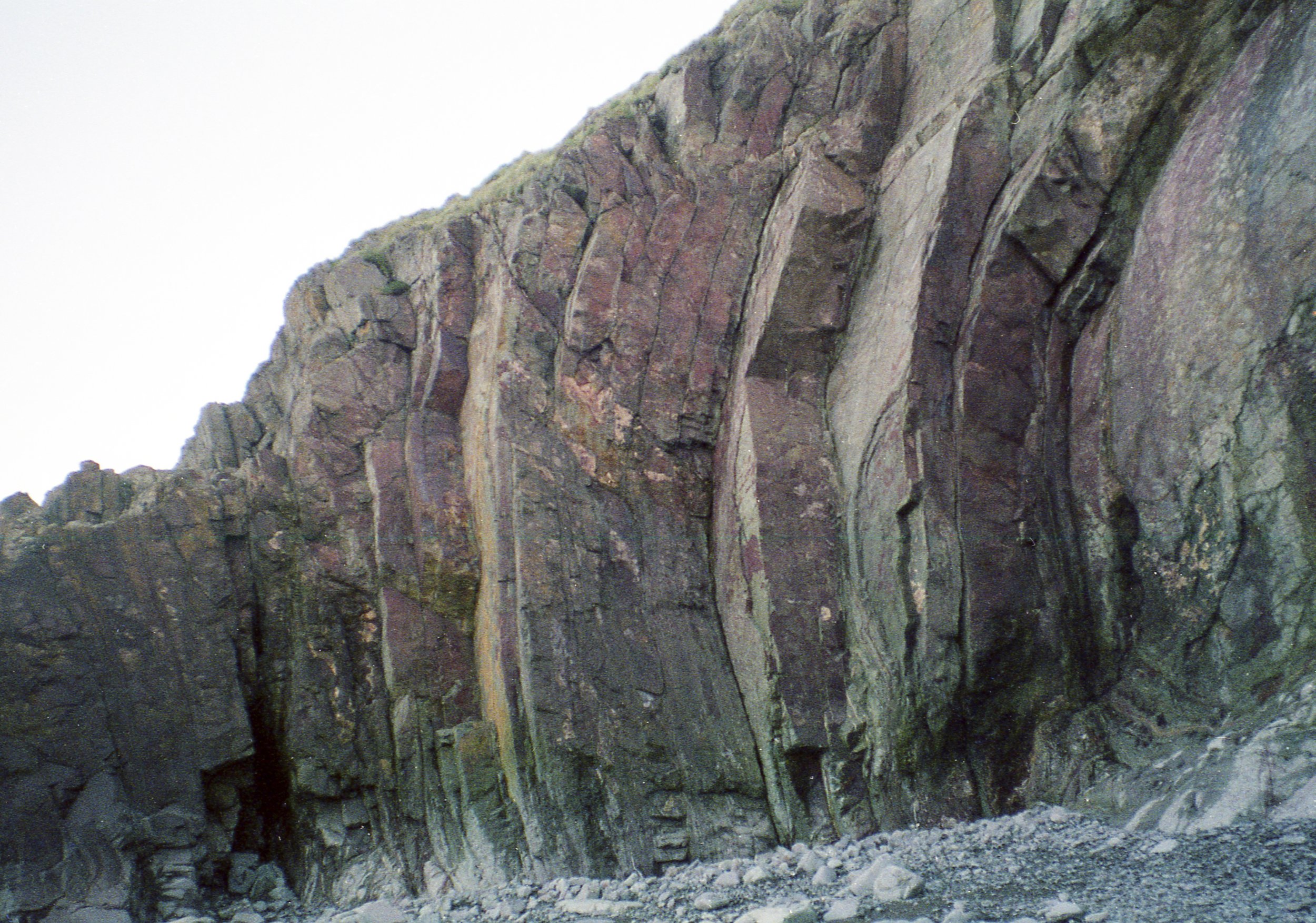
The Exmoor Coast
The Hidden
Edge
of Exmoor
Many years ago I planned to produce an Exmoor coast climbing guidebook jointly with Exmoor coast guru and friend Terry Cheek. Sadly, Terry passed away in 2011, but I still hope to be able to go ahead, in consultation with his family. Meantime you can read about Exmoor coast climbing exploration in his and others’ company in the following article: The Hidden Edge of Exmoor, which was published in High magazine in 2000 (pics by Carl Ryan). By the way, so far as I know, the phrase ‘The Hidden Edge of Exmoor’ was first coined by Kes Webb, whose name binds inextricably with the coast where he worked, painted, and explored.
Update
‘This paper [Coastal Climbs in North Devon] is intended for private circulation only…..It is important that it should not fall into the wrong hands.’ Clement Archer 1961
‘It is not my intention to encourage anyone to visit this wild and dangerous coastline.’ Terry Cheek 1998 from Exmoor [a guidebook to the climbs of the Exmoor coast]
Autumn 2021 and just as our precious afternoon light is stolen once again (clocks gone back), I’ve started typing up reams of my hand-written route descriptions and notes from the 90s. The writing alone is a whole winter’s project, though inconclusive in itself given my objective to produce a suite of free, user-friendly Exmoor coast topos. The problem is that Exmoor’s climbing exploration pre-dates the self-servicing digital guidebook know-how of today which means I should not only recheck the hundreds of routes but also devise a set of crag-shot-topos for each site. That will be a long haul, but – if circumstances are such that it doesn’t happen – I can’t think of a more deserving area not to have a guidebook. At least that scenario will preserve the area’s mystery – a draw for anyone wishing to rediscover the routes for themselves. Meantime should any party wish to sponsor this Exmoor coast guidebook series (its out-of-pocket costs), do please let me know. Again it’s a completely voluntary effort, which nonetheless feels right: climbing consumerism would be at odds with this unspoiled area and its quirky home-made guides from the heart. Just consider the above quotes from two of the area’s pioneers and the reservations and worries they must have had in recording their adventures. By the way, new members to the ‘I keep my clocks on BST’ Club are always welcome.
All users of any free Exmoor coast guides will be encouraged to make a donation to Exmoor Mountain Rescue.

Minehead Bluff
Benji (E6), Minehead Bluff. Pic: Crocker coll. (Terry Cheek)
Pic at top: Terry Cheek climbing Terigrine (VS). Pic: Martin Crocker
Minehead Bluff
‘After rain in spring Henners Combe can be a magnificent sight; its narrow stream can be very wild – leaping and cascading down to the beach.’ Terry Cheek, Exmoor (1998 edition)
Well beyond the shadow of Hurlstone Point across the shimmering Selworthy Sands nestles Minehead Bluff, hanging from the valley of Henners Combe. Most early activists were absorbed in the Exmoor traverse and Hurlstone and so didn’t give the site a second glance; after all it was on the small side, tricky to reach, and its leaning walls must have appeared unclimbable. Inevitably the crags were probed by the area’s first modern climber, Terry Cheek, who left behind a characteristically quirky quota in the mid-90s.
Five years or so after Cheek’s Terigrine, the main leaning wall yielded a bloom of hard face routes up to E6, offering a stunning complement to Hurlstone’s slabs. Adjacent boulder-problems and highballs add to the attraction. Fast forward a further 20 years, and it may be that others have since visited and reclimbed the routes and problems, perplexed for a while by the odd peg left in place. The topo should help satisfy curiosity.
Getting to Minehead Bluff requires self-discipline and a bolder effort than Hurlstone, and occasional peregrines mean you may have to give the main cliff a wide berth during the nesting season. I made one of my visits in 1998 after a business meeting in Taunton, nagged by the hastening hands of the wretched clock and fading light. Succumbing to the lure of the siren of short-cuts I zipped sack-laden across a farmer’s field, running, to save time. Unfortunately such misdemeanour didn’t go un-noticed and the farmer, whom I didn’t see, thought my frantic getaway harboured some greater guilt. So he reported the incident to the police, asking for a PNC check since I’d parked adjacent. By good fortune, Terry Cheek – a local bobby – was on duty and reassured the complainant that it was merely an eccentric who meant no harm. Fair cop, I accepted the reprimand from PC Cheek and apologised to the point of tears. Best, therefore, to resist anything including temptation and stick to the cliff-top path.

Hurlstone Point
Ballad of Miracle Dog (E2), Coastguard Wall; Terry Cheek following on the first ascent in 2003. Pic: Martin Crocker
Pic at top: Family Business (VS) Fledgling Slab. Pic: Jonathan Crocker
Hurlstone Point
‘‘In the late-80s and early-90s Terry would show me the bouldering on the beach. He was stronger than me and would power up the overhanging lines, often – to my astonishment – soloing to the top of the cliff!’ Simon Mooney
How come the devil is associated with all the best tunes – and some great crags too? Legend speaks of a competition at Bossington between the devil and a friendly local giant called Grabbist who lived near Dunster. The aim was to see which could throw stones from Hurlstone Point the farthest. Taking turns, two massive sandstone slabs were hurled to form the standing stones of the Whit Stones, their close proximity to each other suggesting a draw.
Casting such myths to the sea, the real battle in the evolving physical world was that of the forces of the Earth’s crust, compressing and crumpling beds of red, yellow, grey, and purple sandstones of lower Devonian age into the hotchpotch of windswept slabs and folds that became Hurlstone Point.
Hurlstone Point is a dramatic, elemental landscape, its indecisiveness dictated by geology which ensures variety for the climber – from the dip-slopes’ graceful tiptoe-slabs to the strike slopes’ impending arm-burners. Of the former, the grandest slab is Coastguard Wall, nebulous in the yawning depths below those tight-roping the coast path eastwards from the closed lookout station. No need to lean out too far though, since a zig-zag scramble towards the Point yields views of the expansive 55-metre high slab if not its rash of holds: ‘The face is covered in small holds tipped inwards concealing them from below. The rock is doubtful but if pulls are made downwards rather than outwards all should be well.’ said Terry Cheek. Beyond, the dip of the sandstone beds undulates and relaxes a little for Fledgling Slab. Solid and crack-adorned, the slab makes for a great VS trip when the tide permits and it is less far for many than Culm. Hereabouts the earliest pioneers, members of Taunton’s the Red Slab Climbing Club, initiated in the mid-1960s a Lord of the Rings precedent with Uruk Hai and Nazgul, thankfully disobeyed by later first ascensionists. One Goblin is quite sufficient.
Grip it and Rip it (V6), Bossington Beach. Pic: Jonathan Crocker
‘The storm ridges in Bossington Beach and the dark stain high on the cliff serve to remind explorers of the risk of being cut off by the tide, or in this case drowned as there is no place to escape the tide under these cliffs.’ Terry Cheek
To the west steep walls under the Point offer dark deeds up to E6 for finger-strong fanatics, though they are oft-frustrated by Machiavellian conditions and gales trumpeting from the wind tunnel of Gull Hole. Devil in Disguise is one. This through-cave is the sea-blasted core of a magnificent folded convex slab facing Ogmore; unfortunately for climbers it is rarely sea-free. For scramblers, at low spring tide a must-do excursion from Bossington Beach takes you through the hole. But beware the tell-tale sounds of the turn of the tide.
Safe from the rip currents that stalk the Point lie the sun-drenched walls above Bossington’s renowned storm shingle beach, helping to secure Hurlstone the accolade of the Exmoor coast’s most ‘popular’ climbing site. A steep but juggy buttress containing the likes of One Way Street (S) excels in the lower grades while adjacent is a selection of long-established beach-bouldering walls where: ‘surprisingly the shingle absorbs the shocks of falls and jumps.’ It’s all pretty pumpy stuff; and various lowball/highball/route options are available to suit grandstanding ambitions – and faith in the malleability of pebbles.
Back aloft, in high winds the path eastwards from the lookout station provides a perilous test of mettle for bold ramblers as well as a portal to Coney Combe. The Combe is a bleak dysfunctional hollow filled with the waste products of the peeling cliff above, a giant black Saruman’s eye once set centrefold observing wobbly humans scratching and skidding, gravely. In the 1990s the cliff was lashed with thin, precarious, slippery and almost always serious face routes thanks to slab-master Simon Mooney. Unfortunately a recent collapse of the central arch means you’d best bring an acquired taste and a set of brushes; or, you could just stay home because: ‘To be honest I’d rather have a beer in the back garden.’ (Anon. 2001).

The Ivy Stone.
Benji’s Last Stand (HVS); Becky Padgett climbing. Pic: Terry Cheek (exmoorwalker) coll.
Section header: Topping out on Kitnor (VS) The Ivy Stone; Mark Padgett climbing. Pic: Terry Cheek (exmoorwalker) coll.
Ivy Stone and bouldering environs
‘Clemmie Archer had always been anxious that we should not be visible on remote beaches… consequently we were in the habit of dressing in army camouflage…’ David Kester Webb from the Hidden Edge of Exmoor, 2011.
Far beneath England’s smallest church at Culbone lies an enigmatic coastline bearing gifts of sandstone that will keep on giving. I recall looking across from Hurlstone Point in the mid-90s occasionally imagining the glint of evening sun on rock fringing its dense woodland. ‘Is there anything over there?’ I would ask local explorer Simon Mooney. But the answer was always an unconvincing ‘no’. An understandable response since I later learned he was embroiled in developing nearby Sir Robert’s Chair, the imperative being to keep imposters out. Yet close up, a few years on, the pin-prick glints had ballooned into 30m high crags and beauty-shows of unexplored boulders.
Centre-stage in this stretch is the Ivystone (or Ivy Stone), a classical buttress of slabs appearing more user-friendly than many other Exmoor coast crags. Here, safe lower grade routes sit cheek by jowl with run-out nasties up to E6. Only at low spring tide does the sea release the cliff from its embrace. Immediately to the east is St Bueno’s Slab which Terry Cheek and I developed in 2002; it’s a bit like a baby bro of Yosemite’s Apron: lots of tenuous smearing but with spaced gear –or, darn it, none at all. We left six routes here up to E5. Celt (E2/3) was one of Terry’s finest leads, and another, Benji’s Last Stand, commemorates his death-defying dog who scampered away unhurt after a 50m fall down Coastguard Wall. Both local legends, RIP.
Either side of Ivy Stone coasts to relish await boulderers who’ve maintained their leg muscles for 350m high walk-outs or 3.5km pebble dashes. I coasteered the lot over 20 years ago, a roll of foam on my back like a Grexy Combe recluse, finding site after site of bouldering and micro-route fun: from the Pink Star Bluff (look out for the pink star), through the Wilderness Bouldering Walls 500m west of the Ivy Stone (boasting ‘the best boulder-problem on the coast’), and across to the Yellowstone pinnacle (an upright eccentric all on its lonesome). So it’s unsurprising to learn from North Devon boulderer Grant Edwards that this is now an up-and-coming area with a growing fan base – such is the spell cast by the Hidden Edge. Just don’t lose touch like me; check out Grant’s website for the low down: exmoorbouldering.com
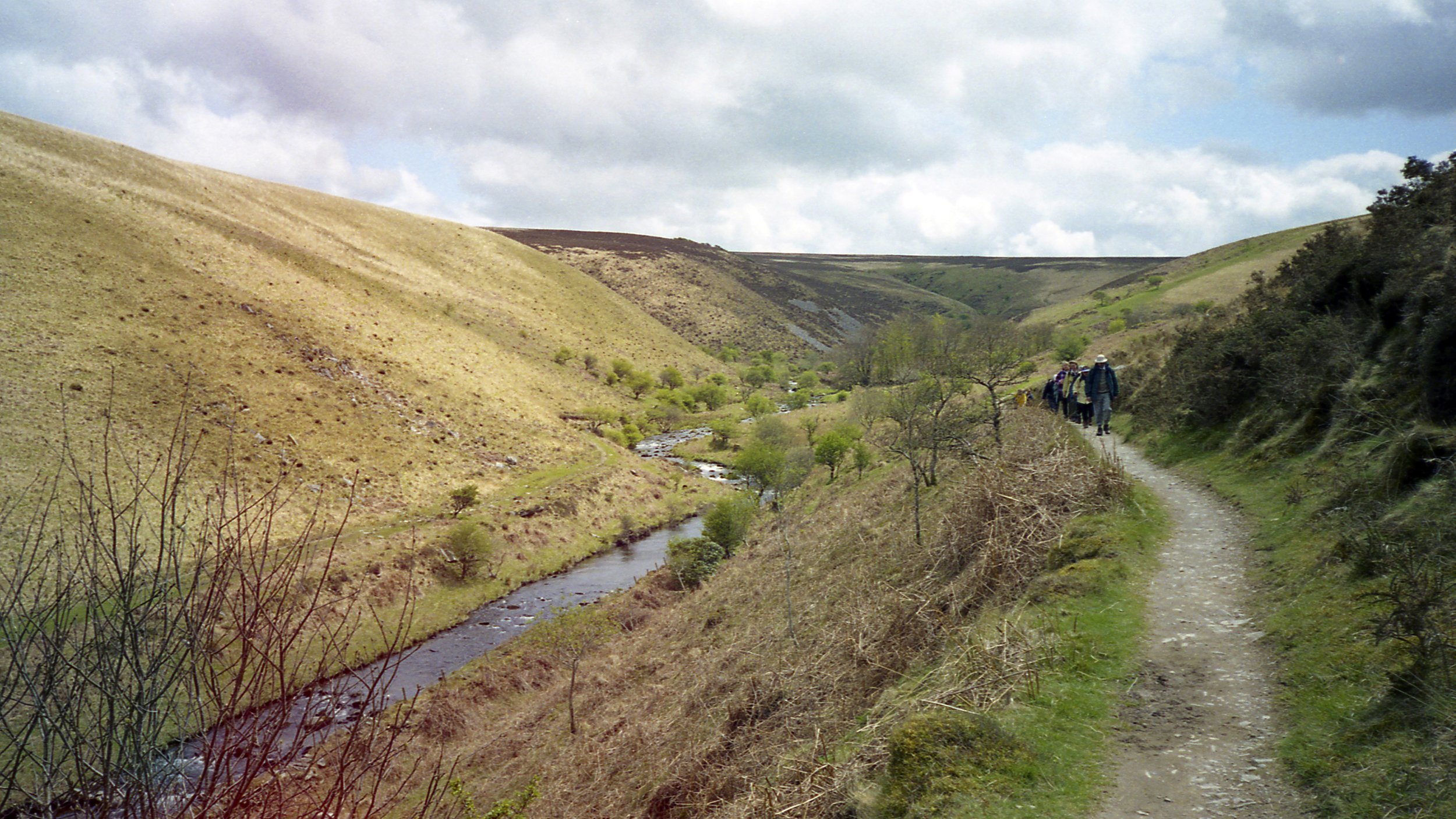
‘Lorna Doone Valley’
Ghost Job (E4), Sir Robert’s Chair. Pic: Crocker coll. (Terry Cheek)
Sir Robert’s Chair
‘This contorted mass of rock has two ‘windows’, one inside the core of a whale-back fold; both are through-caves, giving access to the shoreline below the ‘slabby-slippy’ slopes of Desolate Red.’ David Kester Webb, from the Hidden Edge of Exmoor 2011.
This impressive 60-metre high sandstone face was described as one of Exmoor’s best-kept secrets by South West Climbs, a selected climbs guidebook which unveiled a hit list of its best routes in 2014. Nice try but the crowds didn’t arrive, no doubt kept at bay by tales of its precipitous access and ghosts that would eviscerate your soul. Besides, the A39 was the Silk Road to Baggy, not desolation.
In the mid-90s Sir Robert’s Chair proved the perfect milieu for the enigma of Simon Mooney and local farmer Norman Barnes to explore. Brooding and wooded, the high mysterious coast west of Porlock concealed secrets only a sixth sense and strong legs could find. With Terry Cheek naturally on the scene too, the duo prized themselves with sweet and nimble E1/2s that might have found fame and fortune anywhere less antisocial.
The approach isn’t easy, but who would wish for that? Stumbling around and getting lost can mean you discover more about a place, if only by default. A valued solitary parking place next to Dogsworthy Cottage on the A39 has long been infilled and visitors must now park on Countisbury Common, reaching the coast path via Kipscombe Cottage and Farm. Along this path lie Desolate and Desolation Point, named to sink spirits only so they may be lifted again by the extraordinary rock landscapes beyond.

Countisbury
Countisbury Cove: The Amphitheatre
‘If I could have found just one good runner in the top pitch to abseil from I would have happily admitted defeat.’ Terry Cheek, reflecting upon his first ascent of Petty Whin in 1995.
My first foray to The Amphitheatre was in 1997, having taken an hour’s break from kerfuffles on Sir Robert’s Chair. I was once again in the company of top Exmoor cragsman Terry Cheek, who seemed to know the coast inside out. ‘I think you’ll find something of interest here’ said Terry, smiling knowingly. And so it was, for slumbering amidst the contorted strata was a treasure trove of concertinaed corners and arêtes – and some of the most delicious sandstone on the coast. That was my 1998 mapped out then!
Countisbury Cove proved a fascinating, remote, and sublimely peaceful place to unwind – stealing in for unclimbed lines galore as soon as the tide allowed, and escaping invariably by paddling out. One of the most fun parts was finding a way in from the west that could expand upon the climbing time permitted by an approach from Sir Robert’s Chair to the east. It sounded a noble idea until Nigel Coe and I got imprisoned by impenetrable gorse forest in the hobgoblin gully of Pudleep Gurt. After being poked, prodded and ultimately lacerated, we eventually emerged on the foreshore, after a 30 metre abseil. But, don’t panic, we found a much better access route just to the west, which I improved upon during my next visit. It’s a complicated day out, like many an Exmoor coast adventure, yet visitors need only remember Ernie Skeggs, since his seat on the coast path steers the way down.
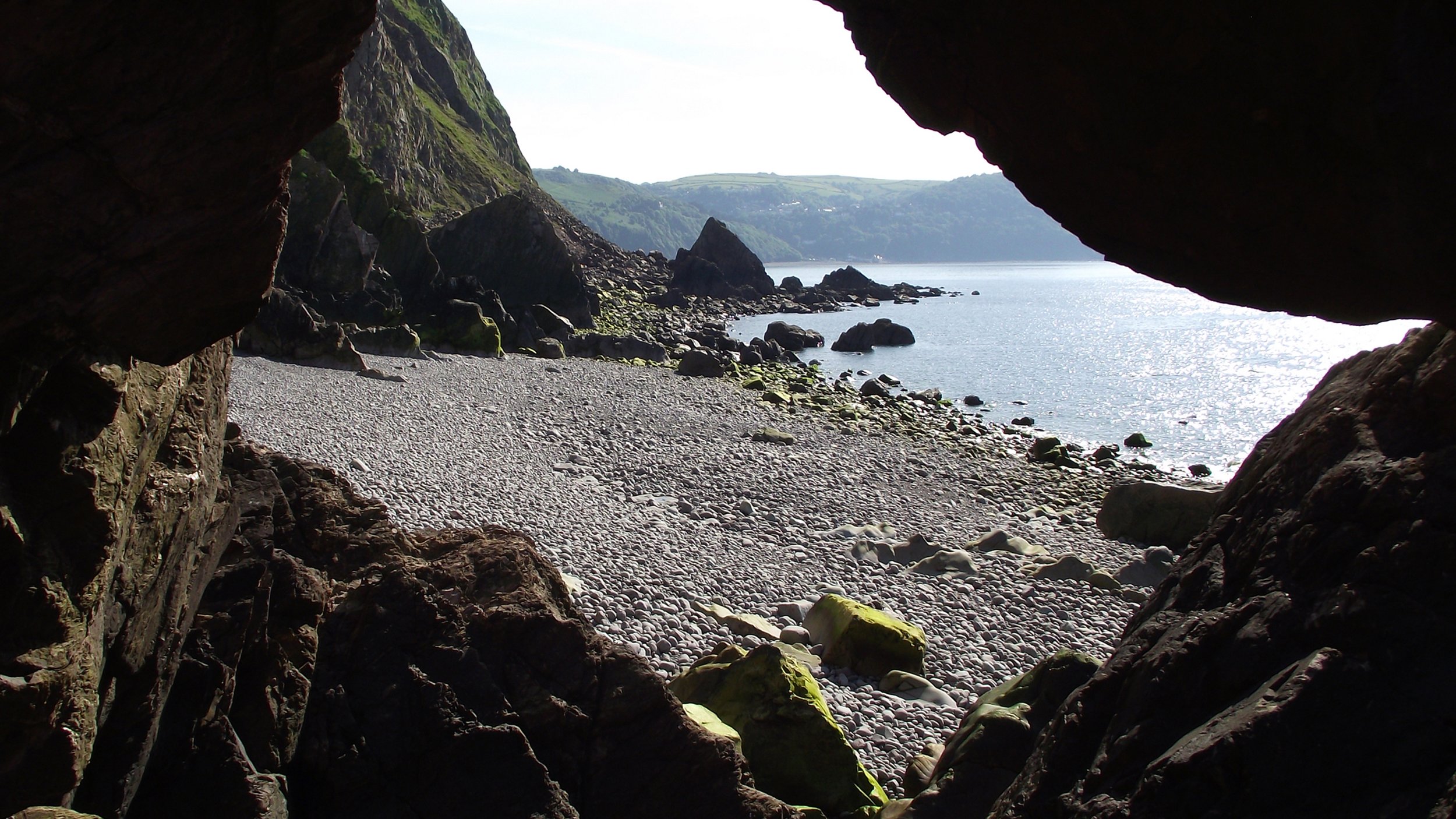
Foreland Point
The Crustacea Fin with Landslip Stack behind, Foreland Point. Lynmouth and Valley of Rocks make up the background. Pic: Martin Crocker
Foreland Point
‘A wonderland of foreshore pinnacles, compact slabs, crazy walls of overlaps – and solitude.’
‘Jim stretched out and fell asleep in the sun while I checked out a route on the Crazy Wall of Overlaps. Seemingly within minutes a helicopter was slapping blades overhead searching for signs of life. Jim stirred, I gave the thumbs up to the helicopter pilot, and the route became The Sleeping Dead.’ Diary entries, April 1997.
Foreland Point is one of the most important climbing sites on the Exmoor coast, on a par with Hurlstone Point but hidden and considerably less accessible.
A lavish spread of pinnacles and slabs sit on the foreshore in front of a huge mountainous slope, like giant shark fins erupting from the beach. Elsewhere smooth-as-Stealth slabs are complemented by sun-clad walls perforated with pockets and jugs. On the back-cliff the Crazy Wall of Overlaps supplies a trio of E5/6s which eat cams and calories. Tidal cut-off points either end of the foreshore enhance the commitment and imbue the search for alternative approaches that deliver longer climbing intervals. If you get trapped, The Kamikaze Sheep Escape Route (IV+) supplies a carcass-ridden way out.
Viewed from a boat, the magnitude of the site becomes clear: massively bedded hard sandstones dip about 60 degrees to the north creating slabs and overlaps, with pointed reefs like prongs combing the sea. Above is heather-clad Foreland, a path slicing down from it through scree to the Foreland lighthouse, now holiday accommodation owned by The National Trust. Long gone are the days when you could park up at the lighthouse and leave a pleadingly polite note for the keeper. A new solution was needed and in 2014 I found myself towing 150m of rope back and forth along the coast path in an Ikea bag in search of a new descent. Not quite Shackleton, but worth a few raised eyebrows if not offers of help. After prospecting, the Landslip Descent route was opened up: a 180m abseil/scramble landing you at the Landslip Stack in the middle of a deserted beach. It unlocked a two-year rejuvenation for site and soul.
Uncharacteristically the cliff-line faces southwest making for open and uplifting climbing free of the darkness and doom of the Lynton Slates. A wide range of climbing awaits free-thinkers, including some sensational bouldering on the most tactile sandstone imaginable. Many days I visited for the bouldering alone, utilising a mat I’d left jammed in the landslip for over a year. Yet try as I may I ultimately couldn’t put off the day when I had to haul the damn mat up the huge back-breaking spur of Callow Slip.
Callow Slip gives preferential access to Gun Caverns, which holds futuristic lines to complement those of the present. Seafaring folk regale the salvo as Atlantic breakers blast into the caves, their energy reorganised as great cannon returning fire, rolling and rumbling back across the seas. Following the demise of the Sillery Sands tourist path, it also gives the best access to the modern bouldering on the Blackheads where slick walls and overhangs host myriad problems up to V12. Just being able to marvel up at the cataclysmic chasm of Great Red is a gift of the Exmoor coast.

Jumaring home, 150m above the Landslip Stack

The 1997 access route: John Harwood abbing over the 60m high Crazy Wall of Overlaps. Pic: Martin Crocker

Jim Woolmington following on the first ascent of Third Parallel (E3), Landward Stack. Pic: Martin Crocker
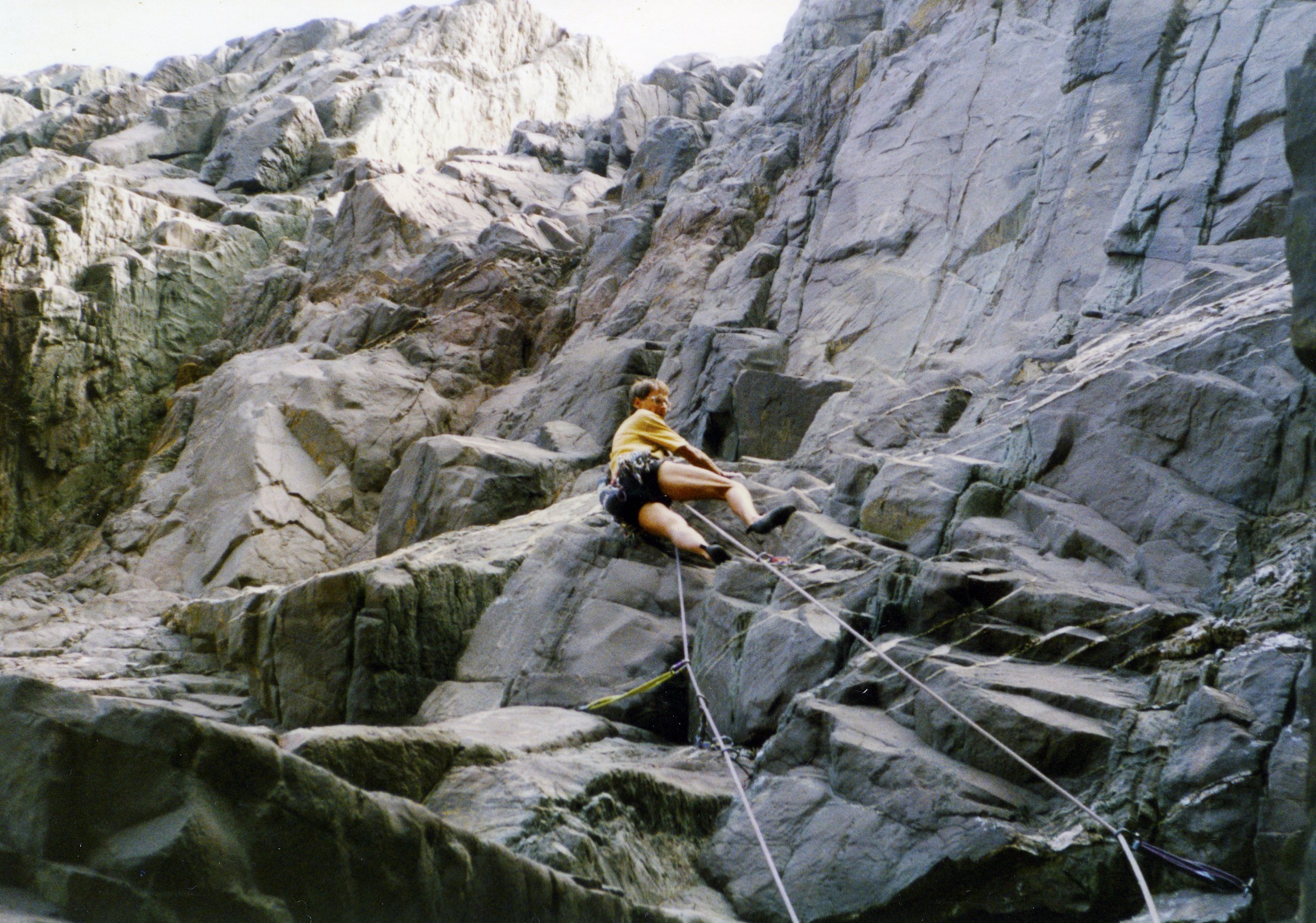
Perchance to Dream (E6), Crazy Wall of Overlaps; first ascent. Pic: Crocker coll. (John Harwood)
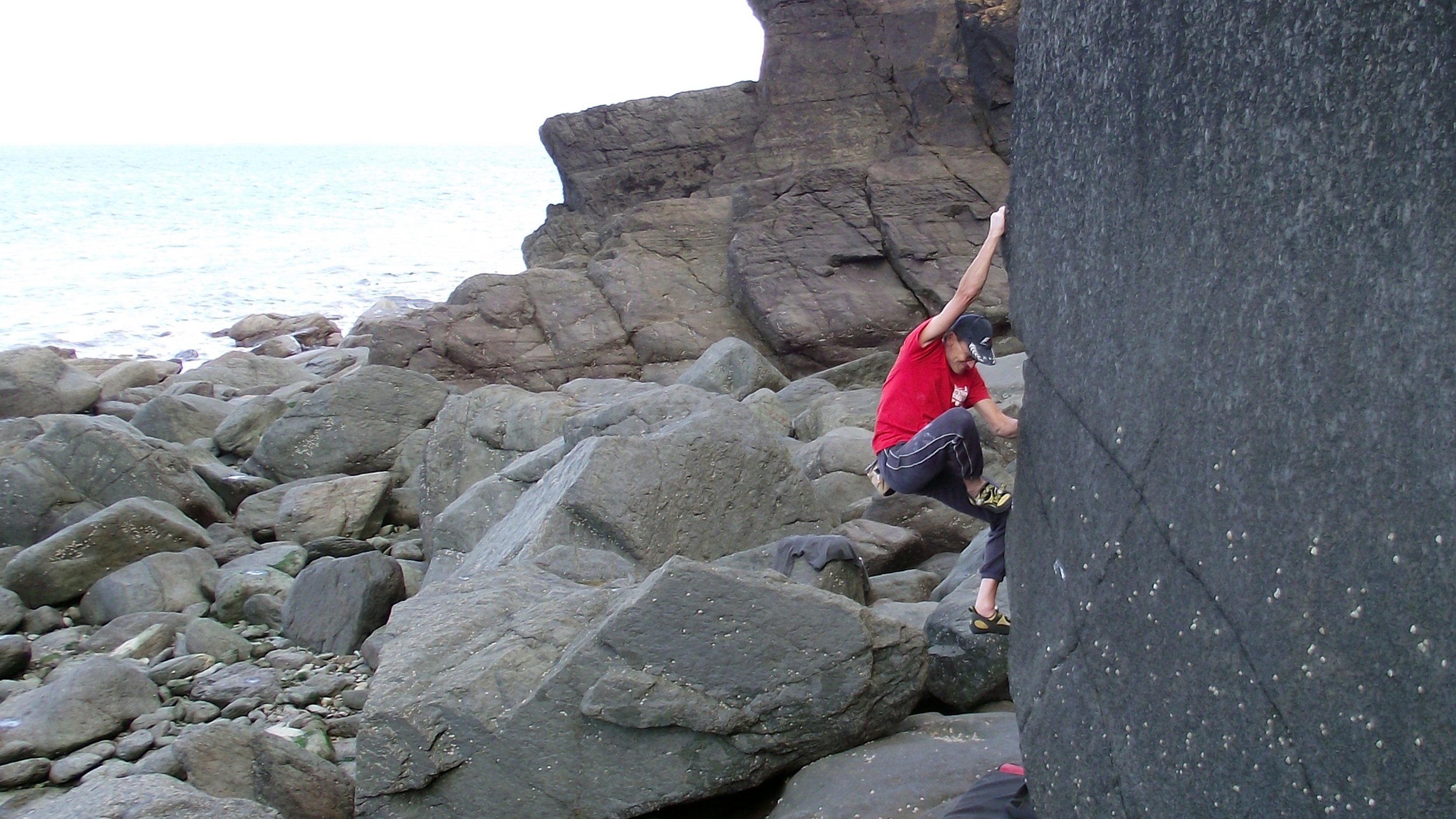
The Lynmouth Boulders
‘Exmoor always guarantees a unique climbing experience in a beautiful and secluded environment; please don’t leave any litter.’ From Exmoor Coast Bouldering: A mini-guide to bouldering at Lynmouth by Grant Edwards
I can’t remember any of the Exmoor activists I climbed with in the 90s ever talking about the stacks of bric-à-brac boulders west of Lynmouth. But I guess mere boulders would not have registered against the backdrop of giant slate cliffs, as, clock-watching, the Exmoor coast explorers hastened to pass the most trying and tide-sensitive section of the traverse: Lynmouth to Wringcliff Bay. Yet, latterly, in his The Hidden Edge of Exmoor, Kes Webb noted: ‘Many of the stones are the size of cars, rectangular and some boldly ripple-marked’.
A flick through javu (Dave Henderson’s website) in 2013 unexpectedly landed me on Grant Edwards’ free and comprehensive guide to the Lynmouth boulders. An excited visit confirmed the boulders to be outstanding, offering grades that even pedestrians like me could handle, despite being a playground of Devon’s bouldering elite. So, great lines and rock but, notwithstanding grades, the bouldering here isn’t completely free of the stresses of Exmoor adventure climbing. Some of the best problems are high, and – especially if you come on your own – they’ll feel more like routes. One not to miss is the ultimate micro-arête of Anarchy Arête (*** V1; E3 5b as an on-sight solo).
What proved equally tantalising is that the guys had stretched out eastwards towards Foreland Point, a favourite wilderness bouldering spot of mine since the mid-90s, their forays seemingly ending at Upper Blackhead. Perhaps it was time to beat a retreat because of the prospect of torrid, pad-burdened escapes up mountainous slopes of tot?
Grant’s downloadable guide can be found at:
http://www.javu.co.uk/Climbing/Guides/Lynmouth_EastGuide.pdf
A taster topo might materialise here some time (though strictly avoiding repetition and plagiarism – commerce-driven or otherwise!). Meantime here are a few pics taken by my son, Jonathan.
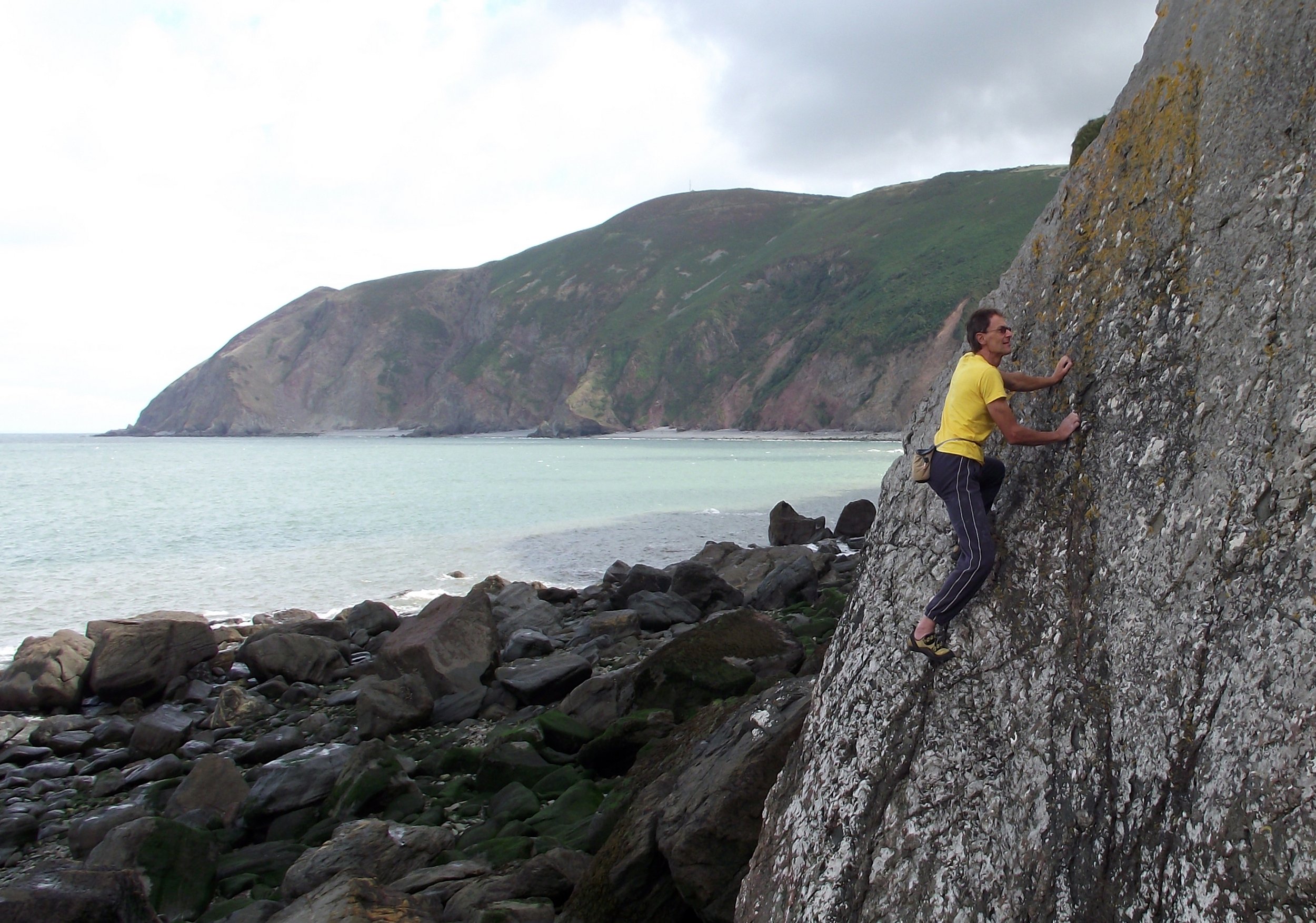
Big Slab Left HVS 4b Foreland Point in the background

Anarchy Arête (E3 5b V1)

F.E.A.R. (E2 5a/b V0+)

Tutan Come On (V2)
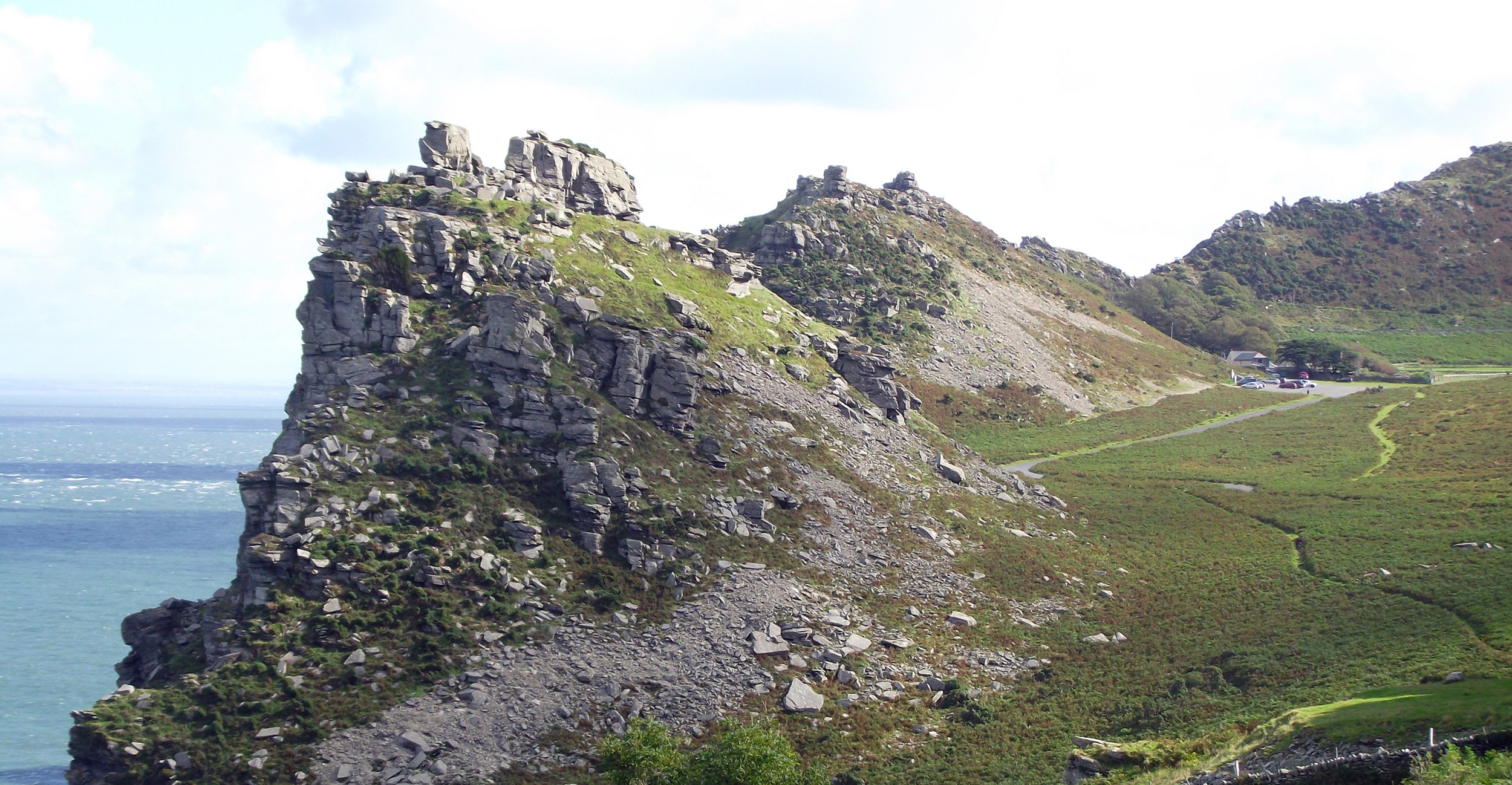
Valley of Rocks
Seagull Salad (E1), Yellow Stone. Pic: Carl Ryan
Valley of Rocks
‘The huge zawn we nicknamed Mother Meldrum’s Gut was attempted but with retreat from half-height after failed-A4 i.e. shale hooking above the belay off 3 knifeblades each inserted only ½ inch.’ Ian Parnell recalls his first effort on Glad to be Trad, a ground-up epic in West Inlet.
Nestling in a picture-postcard valley just west of Lynton is a vignette of pinnacles, blocks and monoliths suspended above a precipice falling 150m to the sea. Fashioned by ice and wind, Lynton Slates leave ragged twisting shapes along mountain-like ridges paralleled by paths that were once the pastime of English poets. Yet for much of the year any romanticised notion of bleakness is pounded away by legions of visitors. Way beyond their reach, at sea level, breakers exploit the rectangular geology by plucking great cuboid chunks from the cliffs. A honeycomb of caves, gullies, and inlets, is created – adding to the challenge of exploration and the apogee of traverses.
By way of handling, the rock is a nuanced taste. Away from the sea the outcrops are solid, even sunny – great for chilled leading, family top-roping, or soloing.; but seawards it exhibits potential for notoriety with black roofs, crusty shale and sandstones, and difficult gear – all conspiring to raise suspicions and even fear above the restless Bristol Channel swell.
Of the sea-cliffs Yellow Stone is the pearl, a delicate-yellow soul when dressed in lichen for the afternoon sun. All here is not quite desperate; a choice of ace protectable E3s is complemented by Archer’s Lost Route, a 40m Severe corner, and others of a similar grade on nearby Hollerday Buttress. Just to the east a secret sea-cave hides its E4 – E5 heavyweights of southwest classic mould: Blackheart the brusquest of the beasts.
Diverse cliffs attract a range of tactics, rare pioneers with pegs and ground-up ethics arriving for the largest and most daunting cliffs of shale and grass. On seaside Eigerwands towering above Wringcliff Bay, Alpine-style climbing takes over – light-treading stacks of blocks, step-kicking in scree, and praying any fall does not slice the rope on razor shards of giant interlocking slates. It’s the stuff of Clement Archer and Cyril Manning. With so much more to go.

Lee Abbey area
Terry (E5), Lee Cliff; first ascent. Pic: Don Sargeant
Pic at top: Ian Parsons starting up the first ascent of Under the Weather on a Lee Shore (E2). Pic: Martin Crocker
Pic below: Ian Parsons topping out on Terry (E5), during the first ascent. Pic: Martin Crocker
Lee Abbey Estate
‘Where Exmoor meets the sea, you can look out at Wales from the Crosses on the top of the hill – a great place to reflect and encounter Jesus. Or walk deep into the forest on six miles of footpaths, spotting the plants and animals that make the estate their home – including Lee Abbey’s own sheep and cattle. ‘
‘In every season, the creation around us speaks of its Creator. Even the stars at night are clearer in this remote and tranquil place.’
And – also according to its website – the 288-acre Lee Abbey Estate in Exmoor National Park includes woodlands, streams, fields, and even a private beach. But it also nurtures an exciting and dramatic coastline with several important cliffs and bouldering sites. A Christian Retreat and Conference centre, the Abbey finds itself well positioned to illustrate God through its sublime surroundings.
Talking of retreats, by the winter of 1996/1997 I reckoned I deserved a break from climbing and whatever impulse, fear, or longing drives you to climb. My arms were weary and my mind dizzy from clock-watching scarce time outside work. So I embarked on a weekly Exmoor walk: 20-mile circuits along rivers and over hills, matching my whereabouts to low tide so I could incorporate drop-downs to the foreshores to explore the cliffs and to coasteer. That was how I got to know the coast quite well – and some of its remaining secrets. One such descent was to Wringcliff Bay where, concealed peacefully just to the west, a stunning cliff rose 70 metres in undulating pink grooves and jagged forked lightning cracks into the Abbey grounds . What a place to raise spirits!
A few months later a ‘man from the BMC’, Dave Turnbull, cashed in on a previous recce and – no stranger to adventure – he took on the knife-edged off-width, its name The Chimney Sweep evoking dusty-faced tussles with tight squeezes. But for me the main event was the pink groove system which, in 2012, became a memorial to Terry (E5) who lost his battle with cancer six months earlier. This and other 2012 routes were climbed only after a locally negotiated access agreement with Lee Abbey since all the cliff’s routes exit into its grounds, and there are overriding conservation limitations too.
Between the bouldering sites of Lee Bay and Crock Pits lies Crock Point, another fine cliff, though friendlier and more accessible than its spiritual brother. Here storm battered compact sandstones preclude much in the way of gear, and the leads – Culm-like – are serious ventures. There are even a couple of deep water solos, but only for days of calm. Of Crock Pits I know nothing but Grant Edwards tells me: ‘It has some local classics; the landings can vary from beautiful soft sand to an uneven rocky nightmare.’
Finally, note that these cliffs and/or associated access routes are sited on Lee Abbey land. So, it would be politic to read the Lee Cliff access agreement and extrapolate sensibly.
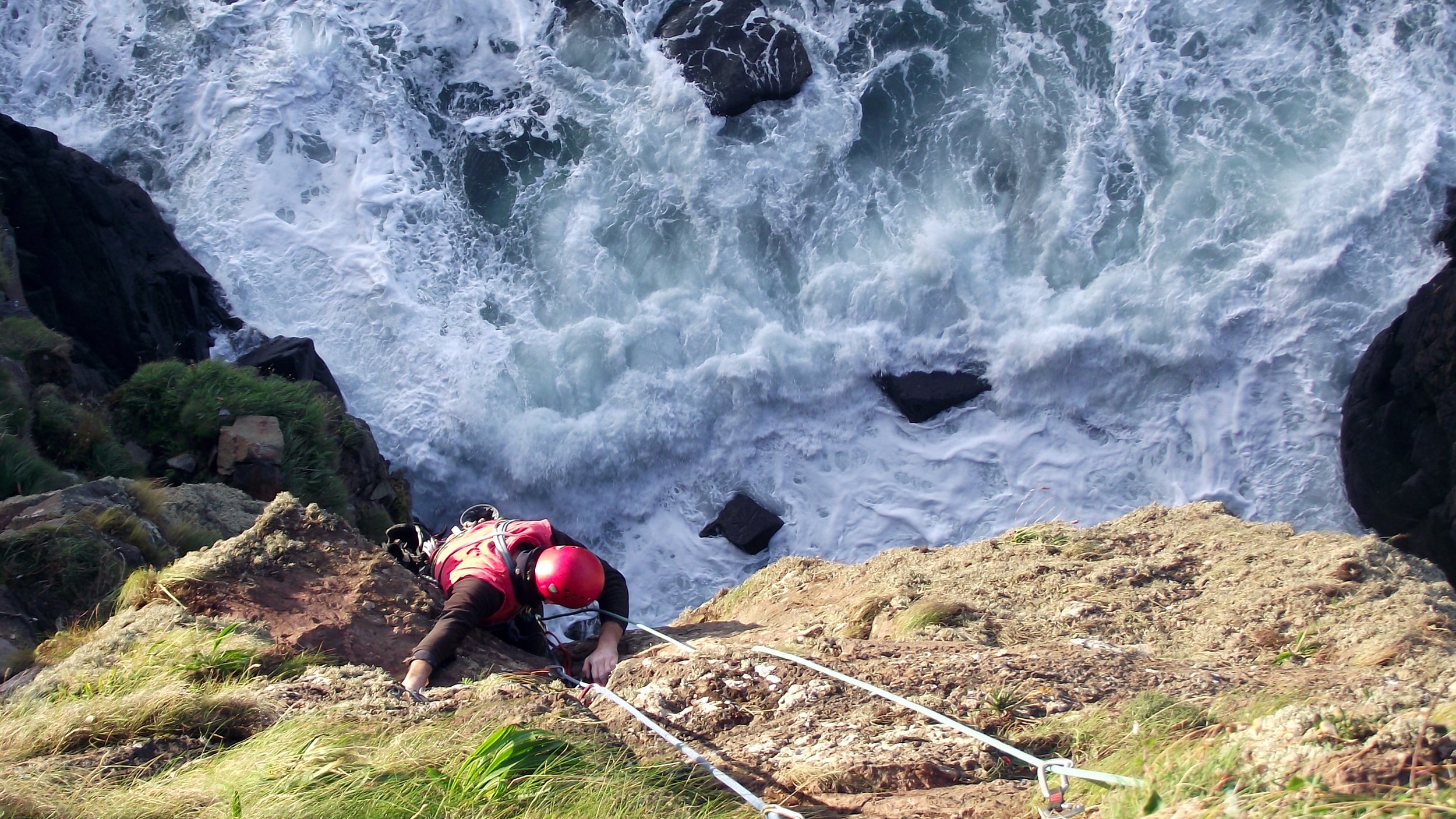

Woody Bay to Heddon’s Mouth
Terry Cheek somewhere in The Inner Sanctuary in 1998, on The Exmoor Traverse. Pic: Martin Crocker
Pic at top: The first ascent of Archer (E6 6b) on the A Cave. Pic: Carl Ryan
Woody Bay to Heddon’s Mouth
‘It would be a proud accomplishment to have traversed the whole of the shoreline from Porlock westwards…..it will not be perfected without special studies of the difficulties and opportunities, as serious as those necessary when an untrodden Alpine peak is to be attacked.’ Newell Arber, The Coast Scenery of North Devon; 1911.
The tantalizing notion of palaeobotanist Arber that the whole of the Exmoor coast could be traversed resonates from generation to generation. During the late-1950s, it became the fixation of retired meteorologist Clement Archer, forefather of Exmoor climbing. Together with his friend Cecil Agar, he began forays west of Woody Bay, descending precipitous slopes with ice axes and bottles of beer for refreshment, traversing this way and that, climbing sections and wading others – his aim being to link the sum of the component parts into a grandiose expedition. All the while – though he occasionally had no choice but to take to the sea – the laws of coasteering evolved around him: ‘to keep feet on rock, and nose above water’. As he explored he meticulously recorded a ‘blog’ detailing his teams’ efforts – in effect a guidebook, released to a chosen few, that inspired and steered his successors to carry on likewise.
North facing and obscure, the Martinhoe sea-cliffs represent the moody soul of Exmoor coast climbing. Huge cliffs plunge to a restless sea from convex slopes clad with head-high heather. Out of sight to walkers on the South West Coast Path is a secret catacomb world of bewildering geometry exemplified by the perforate A Cave – a sturdy Aztec pyramid fashioned in hardest Lynton slates. Archer considered it ‘the most extraordinary discovery in our explorations.’
It took the genius of eccentricity to solve a way past the series of bluffs, the team’s speleological solutions exploiting dark tidal passages through these sheer, faulted headlands. But as tides inevitably threaten, which way to go once committed in the no mans’ land of the Inner Sanctuary? And what of the Girt Fish of Wringapeak – a sea monster with jaws the size of garage doors? In larger-than-life Wagnerian landscapes, specious folklore became a tangible menace to frayed nerves.
Subsequent go-getters who aimed ne’er to set foot in water, namely Cyril Manning, Kester Webb, and Terry Cheek, substantially improved the embryonic 1960s line, thus bequeathing a coherent 2km traverse of VS standard that sucks in climbers eager for 3D adventure in flat data-talk times. Vast potential triggers yearnings en route. As yet it has only been pecked by ‘up-routes’, the most dramatic of which distorts the symmetry of the giant A, if only for a while, thus immortalizing Archer (E6) and his extraordinary energy. Crossings of the tourist version of the Exmoor traverse are still regular if infrequent. The coast generates its devotees, the absence of guidebooks perhaps even adding to the compulsion to discover these places for oneself. While not the most problematic part of the full Exmoor traverse, the Woody Bay to Heddon’s Mouth section is its most consistent and exhilarating – weaving under and over stunning geomorphology and outfoxing its most conspiratorial obstacles.
Come at the wrong time and you won’t be alone. Undisturbed and out of the way nestle great colonies of seabirds, and climbers have thus dutifully limited their climbing to outside the March to July nesting season. Like RSPB warden Cyril Manning ‘who could have become a world-class climber’ (Webb), all the Exmoor explorers appreciated the wildlife and geological value of the Exmoor coast, which enriched their climbing lives – and vice versa.

Terry Cheek following Fish or Man (E4), North Cleave Gut, during the epic first ascent. Pic: Martin Crocker
Spot on (S), Heddon’s Mouth. Jonathan Crocker climbing. Pic: Martin Crocker
Heddon’s Mouth to Great Hangman
‘The limekiln at Heddon’s Mouth made an excellent shelter for the night. On arrival we made a camp fire in an attempt to dry out our sleeping bags which had become saturated while we slept in them in polythene bags. Unfortunately, while converting our ropes into washing lines, I struck my finger with a peg hammer incurring the only injury of the expedition.‘ Terry Cheek sharing memories of the first full Exmoor Coast Traverse, April 1978.
This is one of my favourite stretches of the Exmoor coast, with obscure places to which to descend and disappear off the radar if only for a day. It contains just three modern rock-climbing spots amidst its hog’s back scarps, dark ravines, and tottering mountains of tot. A steep descent and a beach scramble, expertly choreographed with the tide, lands you amongst swallowing landscapes with magnificent waterfalls, offshore stacks, and a sense of exhilarating unease about how best to return to planet Mankind above.
The most easterly of the three sites is Heddon’s Mouth which, for casual walker and visitor alike, is a picture window to the edge of Exmoor, not quite so hidden here. A scenic track leads alongside the River Heddon from the Hunter’s Inn down a V-shaped valley to a charming pebble beach set between inhospitable slate cliffs. For the climber not only does the cove spell the western end of the most popular section of the Exmoor Coast Traverse, but it also offers some short routes and excellent quick-drying bouldering on wave-washed slate.
Not far to the west is Mid-Lymcove Point, close to the cliff where Clement Archer was rescued with 900 feet of Fire Brigade hose, an accident in 1965 that spelt the end of his coastal climbing explorations. ‘Somerset Man Saved in Cliff Drama: Six-hour N. Devon rescue’ boomed the headline in the North Devon Journal Herald. For those undeterred, an easy if exposed scramble introduces you to a pristine band of grey and pink sandstone where deep water solos and extreme leads ignite as embers in the summer evening sun. It goes without saying that this is no place for an accident – but, there, I’ve said it.
Lucretia MacEvil (E5), North Cleave Gut. Terry Cheek on the first ascent in 2003. Pic: Martin Crocker
‘North Cleave Gut is a unique sight, even on this magnificent coast; one gets the feeling of walking up the nave of some vast natural cathedral.’ Clement Archer
And so to Exmoor coast idiosyncrasy North Cleave Gut, a deep and shady zawn with brilliant on-sightable multi-pitch routes locked well away from the sight of rational human beings. Just walking in and out of the gut is an experience. The climbs to date (well, 2003) are located on its western, northeast-facing wall which reaches 60m in height. Many were indeed on-sighted, defying expectations of the loose and scatological – it’s not every day you climb in a gut.
North Cleave Gut was the scene of the most extreme epic for Terry and me. Threatened by a rising spring tide Terry repeatedly fell into the sea while trying to follow Fish or Man, a new route strained from the bowels of the zawn. Floundering and exhausted, his chilling words ‘I’ve had it’ appeared a flat resignation to consign his fate to the sea. A story to be told, we escaped the ravenous gut only in the small hours; and Terry phoned home.
Nearby Bosley Gut provides the standard way down and a judicious eye on the tide the standard way out. Or you can make a well-targeted abseil with a long-enough rope and nous.

Little Hangman
Little Hangman Arête (E1), John Harwood seconding. Pic: Carl Ryan
Pic at top: Blindman’s Bluff (E4); first ascent. Pic: Carl Ryan
Little Hangman
‘Topping out on Little Hangman Arête you will be greeted by the ironic smile of a garden gnome’. But ‘Gordon the gnome felt dejected in this lonely spot and hitched a lift to more convivial climes.’ High mag 210/212.
A provocative name for the Exmoor coast’s most distinctive summit, conjuring up the mood of its sea-cliffs: intimidating and hard-to-access dark sandstone walls and caves where any serious mistake will exact capital punishment. To avoid the noose, you should creep tentatively into the soul of the Hangman; the place deserves respect. Maybe first do a coasteering recce from Wild Pear Beach at low spring tide, second work out the descent to The Gritstone Wall for a welcoming route or two, and third branch out into greater adventures – hereabouts you’re spoiled for choice. You could do worse than to engage Little Hangman Arête.
The early climbing history of Little Hangman hung on the pioneers’ efforts to pass Yes Tor on the full Exmoor coast traverse without taking to the sea or stepping stones as Cecil Agar and Clement Archer did. Upward options were generally shunned (if not a means of escape), before the climbing potential of the place was sampled in 1985 by whizz-kid Dave Thomas. Curiously, Terry Cheek was less than at home here. Terry would always start twitching nervously when I suggested climbing at Little Hangman: ‘This sandstone is too soft; I don’t trust it’ he would argue. His point was proved when I ripped off a big solid-looking boss of rock, no gear between me and him on the belay; close call.
A wise tactic is to keep low and sea-washed on the slabby black Hangman Grits which can be immaculate, despite their begrudging gear. Rise higher through the kaleidoscope of banded colours: oranges, reds, and yellows, and you’ll need to keep more of your wits about you. Whatever your strategy your time on these cliffs will be memorable ones.
Some visits here were alone with Soloist: nerves threadbare at times, but a pure way to meld with the guts of a place, even if within eyeshot of fellow man. Paradoxically any expectation of solotude is washed away by the daily armada of fishing and sight-seeing boats chugging and chuntering 60 metres off shore. They’re not used to seeing climbers here, so thumbs up, middle fingers down: you might need their help one day.









